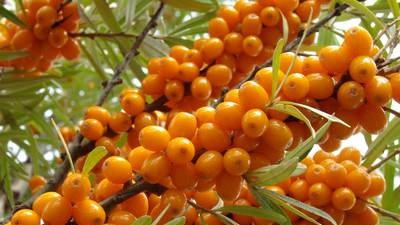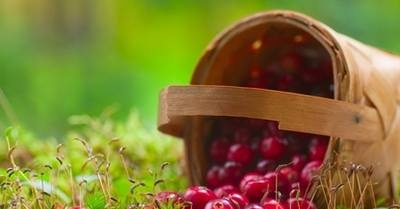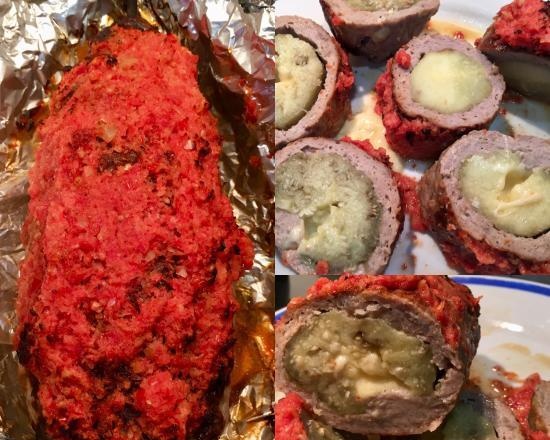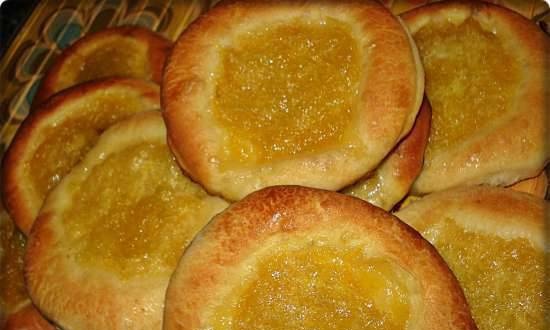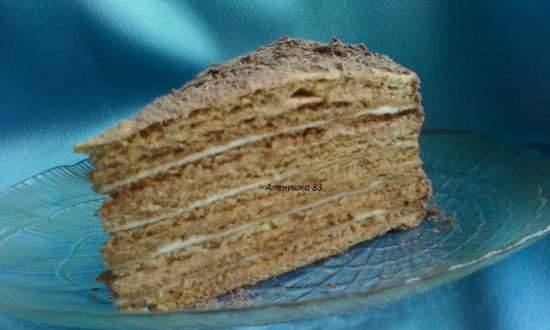|
 Sea buckthorn is one of the few wild plants that has rapidly become a widely known new fruit crop. It is even difficult to imagine that only some 20-25 years ago it was known only as a wild, useful plant. Sea buckthorn grows wild in Siberia and the Caucasus, in Central Asia and in many countries of Europe and Asia. Most often it is a shrub, but there may be a small tree, and sometimes even a large one up to 15 m. Depending on the growing conditions, it also differs greatly in its biological properties. Of the three known types of sea buckthorn, only one grows in our country: sea buckthorn. The local names of this plant are very different: in Siberia and the Far East - dereza, broomstick, gnets, lactarius, broom and even just a thorn, in the Caucasus - dzhakudla, in Central Asia - jeddah. Sea buckthorn is one of the few wild plants that has rapidly become a widely known new fruit crop. It is even difficult to imagine that only some 20-25 years ago it was known only as a wild, useful plant. Sea buckthorn grows wild in Siberia and the Caucasus, in Central Asia and in many countries of Europe and Asia. Most often it is a shrub, but there may be a small tree, and sometimes even a large one up to 15 m. Depending on the growing conditions, it also differs greatly in its biological properties. Of the three known types of sea buckthorn, only one grows in our country: sea buckthorn. The local names of this plant are very different: in Siberia and the Far East - dereza, broomstick, gnets, lactarius, broom and even just a thorn, in the Caucasus - dzhakudla, in Central Asia - jeddah.
 Sea buckthorn has always been a food product. Back in the 18th century, the famous explorer of Siberia, Academician PS Pallas, reported that the local population made jelly, jam from its fruits and served as a great delicacy with milk and cottage cheese. A widespread dish has always been aromatic jelly, which was made from frozen berries, which removed their bitter-sour taste. For the pleasant taste and smell of pineapple, sea buckthorn liqueurs enjoyed good fame throughout Siberia. Liqueurs from it were sold even in St. Petersburg, and in the fruit shops of the capital one could buy its branches covered with fruits. In Mongolia, sea buckthorn has always been consumed with the meat and dairy diet prevailing among the population, and in the Scandinavian countries - as a seasoning for fish soups. Sea buckthorn has always been a food product. Back in the 18th century, the famous explorer of Siberia, Academician PS Pallas, reported that the local population made jelly, jam from its fruits and served as a great delicacy with milk and cottage cheese. A widespread dish has always been aromatic jelly, which was made from frozen berries, which removed their bitter-sour taste. For the pleasant taste and smell of pineapple, sea buckthorn liqueurs enjoyed good fame throughout Siberia. Liqueurs from it were sold even in St. Petersburg, and in the fruit shops of the capital one could buy its branches covered with fruits. In Mongolia, sea buckthorn has always been consumed with the meat and dairy diet prevailing among the population, and in the Scandinavian countries - as a seasoning for fish soups.
 Sea buckthorn has long been valued as a medicinal plant. In folk medicine of Ancient Greece, Rome, China, Tuva, Mongolia, it was used in the treatment of gastrointestinal, pulmonary, hepatic and joint diseases. In Siberia, a decoction of sea buckthorn fruits was used to treat skin rashes, leaves and flowers - against rheumatism, and seeds - as a mild laxative. In Transbaikalia, an aqueous infusion of branches and leaves was used as an astringent. Sea buckthorn has long been valued as a medicinal plant. In folk medicine of Ancient Greece, Rome, China, Tuva, Mongolia, it was used in the treatment of gastrointestinal, pulmonary, hepatic and joint diseases. In Siberia, a decoction of sea buckthorn fruits was used to treat skin rashes, leaves and flowers - against rheumatism, and seeds - as a mild laxative. In Transbaikalia, an aqueous infusion of branches and leaves was used as an astringent.
 But despite the great interest in sea buckthorn, they were in no hurry to introduce it into the culture, but were limited only to collecting fruits from wild plants. IV Michurin was one of the originators of the introduction of this plant into horticulture. On his recommendation, in the 30s in Altai, Academician MA Lisavenko began a great deal of work on the domestication of sea buckthorn. But despite the great interest in sea buckthorn, they were in no hurry to introduce it into the culture, but were limited only to collecting fruits from wild plants. IV Michurin was one of the originators of the introduction of this plant into horticulture. On his recommendation, in the 30s in Altai, Academician MA Lisavenko began a great deal of work on the domestication of sea buckthorn.
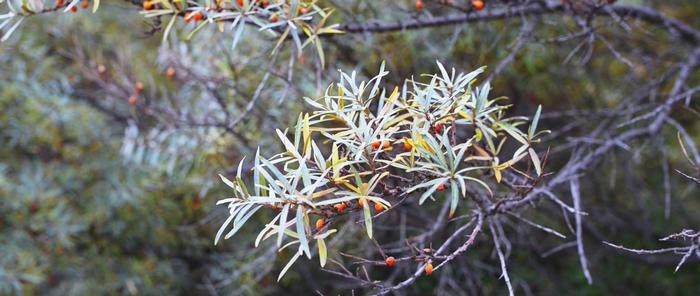 In recent years, studying the biochemical composition of its fruits, scientists have discovered the secret of the extraordinarily healing properties of this plant. It has been found that sea buckthorn is a multivitamin plant. In terms of the content of vitamin C, it is in third place after rose hips and actinidia, it contains from 100 to 700 mg%. It is especially important that this vitamin is well preserved in processed products. The group of vitamins P is large enough in fruits, vitamins B1 and B2, provitamin A are also found; and in terms of vitamin E content, sea buckthorn is unmatched among fruit and berry crops. And this is far from a complete list of vitamins contained in it, in addition to which sea buckthorn fruits contain various acids, 15 trace elements, pectin and other substances vital for humans. But a truly healing miracle of this plant turned out to be oil, which, in terms of the content of biologically active substances, is unmatched among other vegetable oils. In recent years, studying the biochemical composition of its fruits, scientists have discovered the secret of the extraordinarily healing properties of this plant. It has been found that sea buckthorn is a multivitamin plant. In terms of the content of vitamin C, it is in third place after rose hips and actinidia, it contains from 100 to 700 mg%. It is especially important that this vitamin is well preserved in processed products. The group of vitamins P is large enough in fruits, vitamins B1 and B2, provitamin A are also found; and in terms of vitamin E content, sea buckthorn is unmatched among fruit and berry crops. And this is far from a complete list of vitamins contained in it, in addition to which sea buckthorn fruits contain various acids, 15 trace elements, pectin and other substances vital for humans. But a truly healing miracle of this plant turned out to be oil, which, in terms of the content of biologically active substances, is unmatched among other vegetable oils.
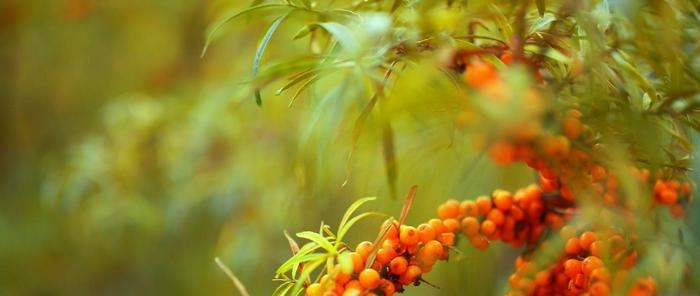 The unusually valuable properties of sea buckthorn led to the emergence of its industrial processing. The first zoned varieties of sea buckthorn appeared in Altai, and the first, albeit small, industrial plantations of it have already been laid. The unusually valuable properties of sea buckthorn led to the emergence of its industrial processing. The first zoned varieties of sea buckthorn appeared in Altai, and the first, albeit small, industrial plantations of it have already been laid.
Sea buckthorn turned out to be interesting for the central regions of Russia. Its active introduction into culture was largely promoted by amateur gardeners.
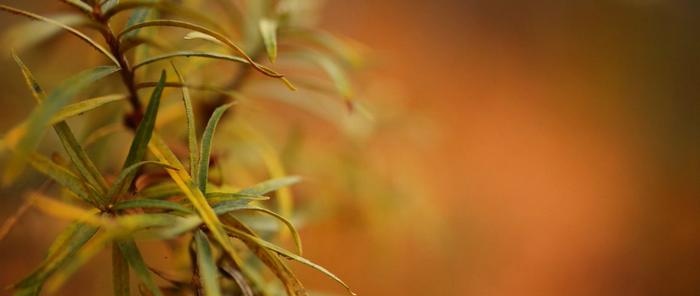 Interest in sea buckthorn has also increased in connection with the possibilities of using it for anti-erosion purposes: to strengthen river banks, ravines, and all kinds of embankments. Interest in sea buckthorn has also increased in connection with the possibilities of using it for anti-erosion purposes: to strengthen river banks, ravines, and all kinds of embankments.
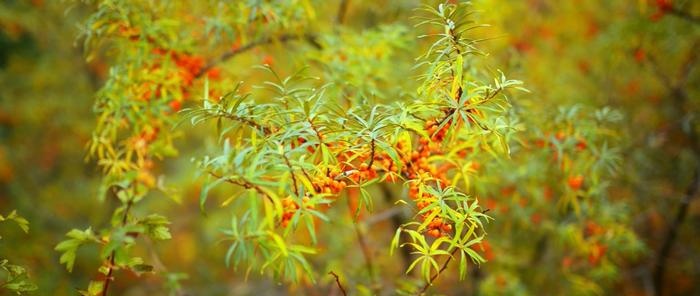 There is one more unusually valuable property of this plant. Nodule formations are formed on the roots, through which the sea buckthorn, with the help of microorganisms, assimilates nitrogen from the air and enriches the soil with it. And recently, another curious possibility of sea buckthorn was revealed. Its thickets are preferred by the pheasant - the only bird that actively destroys the Colorado potato beetle. There is one more unusually valuable property of this plant. Nodule formations are formed on the roots, through which the sea buckthorn, with the help of microorganisms, assimilates nitrogen from the air and enriches the soil with it. And recently, another curious possibility of sea buckthorn was revealed. Its thickets are preferred by the pheasant - the only bird that actively destroys the Colorado potato beetle.
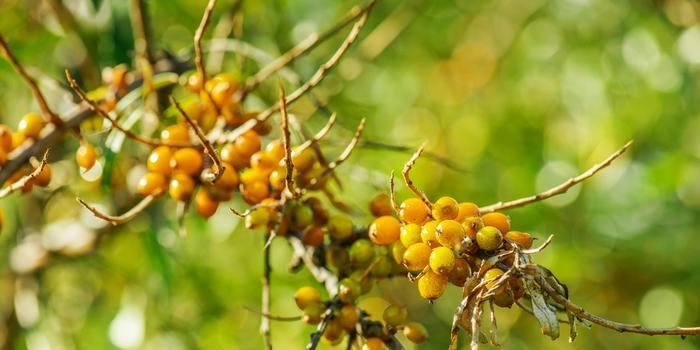 Sea buckthorn is still more of an amateur culture. Its widespread introduction into industrial horticulture is restrained primarily by the difficulty in collecting fruits, which stick tightly and firmly to the branches. There are other complications as well. Outwardly healthy plants often wither in summer. This is due to damage to vascular tissues by harmful soil fungi. Sea buckthorn is still more of an amateur culture. Its widespread introduction into industrial horticulture is restrained primarily by the difficulty in collecting fruits, which stick tightly and firmly to the branches. There are other complications as well. Outwardly healthy plants often wither in summer. This is due to damage to vascular tissues by harmful soil fungi.
 Sea buckthorn has recently appeared in our gardens. Success in its further domestication will depend on the creation of fast-growing, high-yielding varieties with stable fruiting over the years, for various economic uses - dessert, oilseed and canned food, which are necessarily suitable for mechanized harvesting. Improvement of the technology of its reproduction, cultivation and harvesting remains no less important. In all this, amateur gardeners can also provide invaluable assistance to specialists. Sea buckthorn has recently appeared in our gardens. Success in its further domestication will depend on the creation of fast-growing, high-yielding varieties with stable fruiting over the years, for various economic uses - dessert, oilseed and canned food, which are necessarily suitable for mechanized harvesting. Improvement of the technology of its reproduction, cultivation and harvesting remains no less important. In all this, amateur gardeners can also provide invaluable assistance to specialists.
T. A. Frenkina
Both tasty and healthy
- For cooking pastilles for 1 ng of berries, you need to add 1 glass of juice from gooseberries, black and red currants, apples or quince. These sleepyheads have a high gelling ability.
- The juice with sea buckthorn berries are heated until softened, then rubbed through a sieve. The resulting pomace is passed through a meat grinder, mixed with granulated sugar (600 g of sand is taken for 1 kg of pomace). A 1 cm thick mixture is rolled out on a wooden board, dried in an oven heated to 45 ° C (the door should be slightly open). The finished product is cut into rhombuses, cubes, sprinkled with powdered sugar, rolled with a bottle of champagne, laid out in candy boxes.
- Sea buckthorn berries can rub with sugar... Previously, the berries are washed three times with water, thrown onto a sieve, and when they dry, put in a bowl with high edges. For 1 kg of berries, take 1 kg of granulated sugar, stir so that the berries are kneaded, and the sand is saturated with juice. Then the mixture is filled into 4/5 sterilized jars, and the top is covered with sand.
|
 Sea buckthorn is one of the few wild plants that has rapidly become a widely known new fruit crop. It is even difficult to imagine that only some 20-25 years ago it was known only as a wild, useful plant. Sea buckthorn grows wild in Siberia and the Caucasus, in Central Asia and in many countries of Europe and Asia. Most often it is a shrub, but there may be a small tree, and sometimes even a large one up to 15 m. Depending on the growing conditions, it also differs greatly in its biological properties. Of the three known types of sea buckthorn, only one grows in our country: sea buckthorn. The local names of this plant are very different: in Siberia and the Far East - dereza, broomstick, gnets, lactarius, broom and even just a thorn, in the Caucasus - dzhakudla, in Central Asia - jeddah.
Sea buckthorn is one of the few wild plants that has rapidly become a widely known new fruit crop. It is even difficult to imagine that only some 20-25 years ago it was known only as a wild, useful plant. Sea buckthorn grows wild in Siberia and the Caucasus, in Central Asia and in many countries of Europe and Asia. Most often it is a shrub, but there may be a small tree, and sometimes even a large one up to 15 m. Depending on the growing conditions, it also differs greatly in its biological properties. Of the three known types of sea buckthorn, only one grows in our country: sea buckthorn. The local names of this plant are very different: in Siberia and the Far East - dereza, broomstick, gnets, lactarius, broom and even just a thorn, in the Caucasus - dzhakudla, in Central Asia - jeddah. Sea buckthorn has always been a food product. Back in the 18th century, the famous explorer of Siberia, Academician PS Pallas, reported that the local population made jelly, jam from its fruits and served as a great delicacy with milk and cottage cheese. A widespread dish has always been aromatic jelly, which was made from frozen berries, which removed their bitter-sour taste. For the pleasant taste and smell of pineapple, sea buckthorn liqueurs enjoyed good fame throughout Siberia. Liqueurs from it were sold even in St. Petersburg, and in the fruit shops of the capital one could buy its branches covered with fruits. In Mongolia, sea buckthorn has always been consumed with the meat and dairy diet prevailing among the population, and in the Scandinavian countries - as a seasoning for
Sea buckthorn has always been a food product. Back in the 18th century, the famous explorer of Siberia, Academician PS Pallas, reported that the local population made jelly, jam from its fruits and served as a great delicacy with milk and cottage cheese. A widespread dish has always been aromatic jelly, which was made from frozen berries, which removed their bitter-sour taste. For the pleasant taste and smell of pineapple, sea buckthorn liqueurs enjoyed good fame throughout Siberia. Liqueurs from it were sold even in St. Petersburg, and in the fruit shops of the capital one could buy its branches covered with fruits. In Mongolia, sea buckthorn has always been consumed with the meat and dairy diet prevailing among the population, and in the Scandinavian countries - as a seasoning for  Sea buckthorn has long been valued as a medicinal plant. In folk medicine of Ancient Greece, Rome, China, Tuva, Mongolia, it was used in the treatment of gastrointestinal, pulmonary, hepatic and joint diseases. In Siberia, a decoction of sea buckthorn fruits was used to treat skin rashes, leaves and flowers - against rheumatism, and seeds - as a mild laxative. In Transbaikalia, an aqueous infusion of branches and leaves was used as an astringent.
Sea buckthorn has long been valued as a medicinal plant. In folk medicine of Ancient Greece, Rome, China, Tuva, Mongolia, it was used in the treatment of gastrointestinal, pulmonary, hepatic and joint diseases. In Siberia, a decoction of sea buckthorn fruits was used to treat skin rashes, leaves and flowers - against rheumatism, and seeds - as a mild laxative. In Transbaikalia, an aqueous infusion of branches and leaves was used as an astringent. But despite the great interest in sea buckthorn, they were in no hurry to introduce it into the culture, but were limited only to collecting fruits from wild plants. IV Michurin was one of the originators of the introduction of this plant into horticulture. On his recommendation, in the 30s in Altai, Academician MA Lisavenko began a great deal of work on the domestication of sea buckthorn.
But despite the great interest in sea buckthorn, they were in no hurry to introduce it into the culture, but were limited only to collecting fruits from wild plants. IV Michurin was one of the originators of the introduction of this plant into horticulture. On his recommendation, in the 30s in Altai, Academician MA Lisavenko began a great deal of work on the domestication of sea buckthorn. In recent years, studying the biochemical composition of its fruits, scientists have discovered the secret of the extraordinarily healing properties of this plant. It has been found that sea buckthorn is a multivitamin plant. In terms of the content of vitamin C, it is in third place after rose hips and actinidia, it contains from 100 to 700 mg%. It is especially important that this vitamin is well preserved in processed products. The group of vitamins P is large enough in fruits, vitamins B1 and B2, provitamin A are also found; and in terms of vitamin E content, sea buckthorn is unmatched among fruit and berry crops. And this is far from a complete list of vitamins contained in it, in addition to which sea buckthorn fruits contain various acids, 15 trace elements, pectin and other substances vital for humans. But a truly healing miracle of this plant turned out to be oil, which, in terms of the content of biologically active substances, is unmatched among other vegetable oils.
In recent years, studying the biochemical composition of its fruits, scientists have discovered the secret of the extraordinarily healing properties of this plant. It has been found that sea buckthorn is a multivitamin plant. In terms of the content of vitamin C, it is in third place after rose hips and actinidia, it contains from 100 to 700 mg%. It is especially important that this vitamin is well preserved in processed products. The group of vitamins P is large enough in fruits, vitamins B1 and B2, provitamin A are also found; and in terms of vitamin E content, sea buckthorn is unmatched among fruit and berry crops. And this is far from a complete list of vitamins contained in it, in addition to which sea buckthorn fruits contain various acids, 15 trace elements, pectin and other substances vital for humans. But a truly healing miracle of this plant turned out to be oil, which, in terms of the content of biologically active substances, is unmatched among other vegetable oils. The unusually valuable properties of sea buckthorn led to the emergence of its industrial processing. The first zoned varieties of sea buckthorn appeared in Altai, and the first, albeit small, industrial plantations of it have already been laid.
The unusually valuable properties of sea buckthorn led to the emergence of its industrial processing. The first zoned varieties of sea buckthorn appeared in Altai, and the first, albeit small, industrial plantations of it have already been laid. Interest in sea buckthorn has also increased in connection with the possibilities of using it for anti-erosion purposes: to strengthen river banks, ravines, and all kinds of embankments.
Interest in sea buckthorn has also increased in connection with the possibilities of using it for anti-erosion purposes: to strengthen river banks, ravines, and all kinds of embankments. There is one more unusually valuable property of this plant. Nodule formations are formed on the roots, through which the sea buckthorn, with the help of microorganisms, assimilates nitrogen from the air and enriches the soil with it. And recently, another curious possibility of sea buckthorn was revealed. Its thickets are preferred by the pheasant - the only bird that actively destroys the Colorado potato beetle.
There is one more unusually valuable property of this plant. Nodule formations are formed on the roots, through which the sea buckthorn, with the help of microorganisms, assimilates nitrogen from the air and enriches the soil with it. And recently, another curious possibility of sea buckthorn was revealed. Its thickets are preferred by the pheasant - the only bird that actively destroys the Colorado potato beetle. Sea buckthorn is still more of an amateur culture. Its widespread introduction into industrial horticulture is restrained primarily by the difficulty in collecting fruits, which stick tightly and firmly to the branches. There are other complications as well. Outwardly healthy plants often wither in summer. This is due to damage to vascular tissues by harmful soil fungi.
Sea buckthorn is still more of an amateur culture. Its widespread introduction into industrial horticulture is restrained primarily by the difficulty in collecting fruits, which stick tightly and firmly to the branches. There are other complications as well. Outwardly healthy plants often wither in summer. This is due to damage to vascular tissues by harmful soil fungi. Sea buckthorn has recently appeared in our gardens. Success in its further domestication will depend on the creation of fast-growing, high-yielding varieties with stable fruiting over the years, for various economic uses - dessert, oilseed and canned food, which are necessarily suitable for mechanized harvesting. Improvement of the technology of its reproduction, cultivation and harvesting remains no less important. In all this, amateur gardeners can also provide invaluable assistance to specialists.
Sea buckthorn has recently appeared in our gardens. Success in its further domestication will depend on the creation of fast-growing, high-yielding varieties with stable fruiting over the years, for various economic uses - dessert, oilseed and canned food, which are necessarily suitable for mechanized harvesting. Improvement of the technology of its reproduction, cultivation and harvesting remains no less important. In all this, amateur gardeners can also provide invaluable assistance to specialists.














